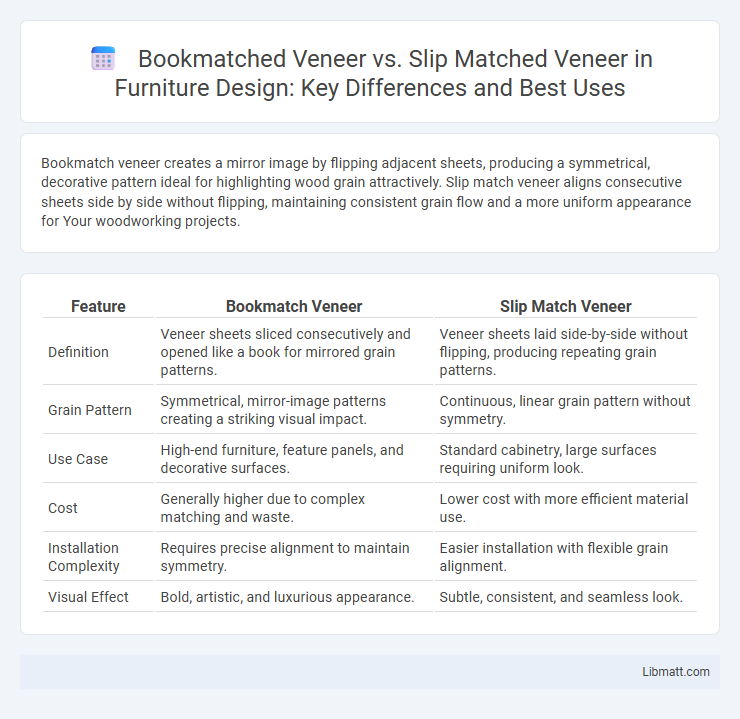Bookmatch veneer creates a mirror image by flipping adjacent sheets, producing a symmetrical, decorative pattern ideal for highlighting wood grain attractively. Slip match veneer aligns consecutive sheets side by side without flipping, maintaining consistent grain flow and a more uniform appearance for Your woodworking projects.
Table of Comparison
| Feature | Bookmatch Veneer | Slip Match Veneer |
|---|---|---|
| Definition | Veneer sheets sliced consecutively and opened like a book for mirrored grain patterns. | Veneer sheets laid side-by-side without flipping, producing repeating grain patterns. |
| Grain Pattern | Symmetrical, mirror-image patterns creating a striking visual impact. | Continuous, linear grain pattern without symmetry. |
| Use Case | High-end furniture, feature panels, and decorative surfaces. | Standard cabinetry, large surfaces requiring uniform look. |
| Cost | Generally higher due to complex matching and waste. | Lower cost with more efficient material use. |
| Installation Complexity | Requires precise alignment to maintain symmetry. | Easier installation with flexible grain alignment. |
| Visual Effect | Bold, artistic, and luxurious appearance. | Subtle, consistent, and seamless look. |
Introduction to Veneer Matching Techniques
Bookmatch veneer creates a mirrored pattern by joining two adjacent veneer sheets, forming symmetrical designs that enhance visual symmetry and balance in cabinetry and furniture. Slip match veneer aligns consecutive sheets side-by-side without mirroring, producing a continuous grain flow ideal for creating a linear and seamless appearance across panels. These matching techniques optimize aesthetic consistency and showcase natural wood patterns in architectural woodwork.
What is Bookmatch Veneer?
Bookmatch veneer is a woodworking technique where two consecutive veneer sheets are opened like a book, creating a mirror image pattern that enhances the natural grain's symmetry and visual appeal. This method highlights the wood's unique patterns, offering a striking and balanced aesthetic often used in high-end cabinetry and furniture. Understanding this technique can help you choose the best veneer matching method to enhance your project's design.
What is Slip Match Veneer?
Slip match veneer involves aligning consecutive veneer sheets side by side from the same flitch or log, creating a continuous and consistent grain pattern across the surface. Unlike bookmatch veneer, where adjacent sheets are mirrored to form symmetrical patterns, slip match offers a natural, linear flow without mirrored effects. Your choice of slip match veneer enhances visual uniformity while maintaining the wood's authentic texture and character.
Visual Differences: Bookmatch vs Slip Match
Bookmatch veneer displays a mirrored, symmetrical pattern where two adjacent veneer sheets are opened like a book, creating a striking, continuous grain reflection. Slip match veneer arranges consecutive sheets side by side without flipping, resulting in a more uniform, linear grain flow without mirror images. The visual difference is pronounced: bookmatch emphasizes dramatic symmetry and contrast, while slip match offers consistent, natural wood appearance with subtle variation.
Aesthetic Impact on Furniture Design
Bookmatch veneer creates a symmetrical, mirror-image pattern that enhances the visual appeal by highlighting natural grain variations, making furniture pieces look more luxurious and artistic. Slip match veneer offers a continuous, linear grain flow that provides a clean, modern aesthetic ideal for minimalist or contemporary furniture designs. Both techniques influence the perception of craftsmanship and style, with bookmatching emphasizing elegance and slip matching emphasizing simplicity.
Strengths and Limitations of Bookmatch Veneer
Bookmatch veneer creates a symmetrical, mirror-image pattern by joining two adjacent veneer sheets, enhancing visual appeal and making it ideal for decorative applications. Its strength lies in producing a balanced, harmonious look that highlights unique grain patterns, but it may reveal imperfections more prominently, requiring careful selection and alignment. Your choice should consider that Bookmatch veneer demands precise craftsmanship and can be less forgiving in high-wear environments compared to other matching techniques.
Advantages and Drawbacks of Slip Match Veneer
Slip match veneer offers a seamless, consistent grain pattern that enhances the visual flow across panels, making it ideal for modern, minimalist interiors. Its production process is more efficient and economical compared to bookmatch veneer, resulting in lower material costs and less waste. However, slip match veneer may lack the dramatic mirrored effect found in bookmatch, which can reduce its appeal for designs emphasizing symmetry and bold visual statements.
Choosing the Right Veneer for Your Project
Bookmatch veneer offers a symmetrical, mirror-image pattern ideal for creating dramatic, eye-catching surfaces that emphasize the natural beauty of wood grain. Slip match veneer provides a more uniform, consistent appearance by aligning adjacent veneer sheets without flipping them, making it suitable for modern, minimalist designs. Selecting the right veneer depends on your desired aesthetic effect, project scale, and wood species, with bookmatching enhancing focal points and slip matching ensuring seamless, subtle continuity.
Cost and Material Considerations
Bookmatch veneer involves pairing consecutive veneer sheets to create a mirror image effect, offering a more visually striking appearance but typically at a higher cost due to increased material waste and labor. Slip match veneer arranges veneer sheets side by side without mirroring, reducing waste and making it more cost-effective while still providing a consistent and balanced grain pattern. Material considerations include the type of wood species used and the required yield, with bookmatching demanding more precise cuts and alignment, impacting both material utilization and price.
Final Thoughts: Bookmatch or Slip Match?
Choosing between bookmatch veneer and slip match veneer depends on your desired visual impact and project requirements. Bookmatch veneer creates a mirrored, symmetrical pattern ideal for stunning focal points, while slip match veneer offers a more continuous, consistent grain flow suitable for larger surfaces. Your selection should align with the room's aesthetic and budget, ensuring the final installation highlights the natural beauty of the wood.
Bookmatch veneer vs slip match veneer Infographic

 libmatt.com
libmatt.com